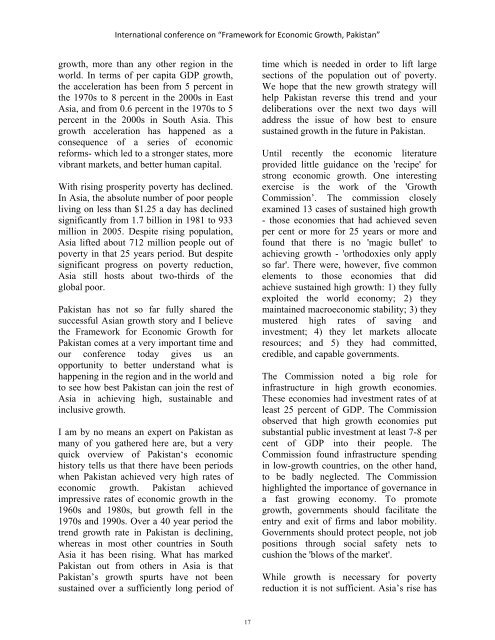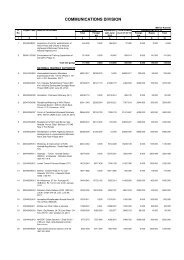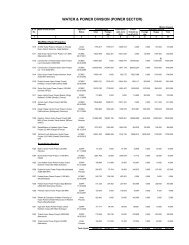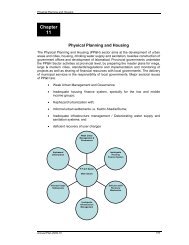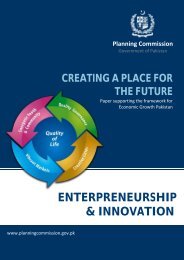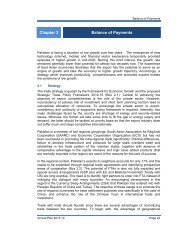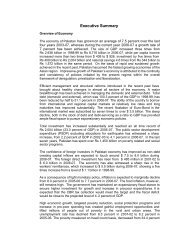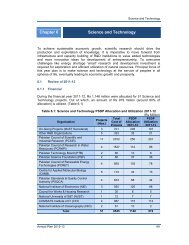Framework for Economic Growth, Pakistan - Planning Commission
Framework for Economic Growth, Pakistan - Planning Commission
Framework for Economic Growth, Pakistan - Planning Commission
Create successful ePaper yourself
Turn your PDF publications into a flip-book with our unique Google optimized e-Paper software.
International conference on “<strong>Framework</strong> <strong>for</strong> <strong>Economic</strong> <strong>Growth</strong>, <strong>Pakistan</strong>”growth, more than any other region in theworld. In terms of per capita GDP growth,the acceleration has been from 5 percent inthe 1970s to 8 percent in the 2000s in EastAsia, and from 0.6 percent in the 1970s to 5percent in the 2000s in South Asia. Thisgrowth acceleration has happened as aconsequence of a series of economicre<strong>for</strong>ms- which led to a stronger states, morevibrant markets, and better human capital.With rising prosperity poverty has declined.In Asia, the absolute number of poor peopleliving on less than $1.25 a day has declinedsignificantly from 1.7 billion in 1981 to 933million in 2005. Despite rising population,Asia lifted about 712 million people out ofpoverty in that 25 years period. But despitesignificant progress on poverty reduction,Asia still hosts about two-thirds of theglobal poor.<strong>Pakistan</strong> has not so far fully shared thesuccessful Asian growth story and I believethe <strong>Framework</strong> <strong>for</strong> <strong>Economic</strong> <strong>Growth</strong> <strong>for</strong><strong>Pakistan</strong> comes at a very important time andour conference today gives us anopportunity to better understand what ishappening in the region and in the world andto see how best <strong>Pakistan</strong> can join the rest ofAsia in achieving high, sustainable andinclusive growth.I am by no means an expert on <strong>Pakistan</strong> asmany of you gathered here are, but a veryquick overview of <strong>Pakistan</strong>‘s economichistory tells us that there have been periodswhen <strong>Pakistan</strong> achieved very high rates ofeconomic growth. <strong>Pakistan</strong> achievedimpressive rates of economic growth in the1960s and 1980s, but growth fell in the1970s and 1990s. Over a 40 year period thetrend growth rate in <strong>Pakistan</strong> is declining,whereas in most other countries in SouthAsia it has been rising. What has marked<strong>Pakistan</strong> out from others in Asia is that<strong>Pakistan</strong>’s growth spurts have not beensustained over a sufficiently long period oftime which is needed in order to lift largesections of the population out of poverty.We hope that the new growth strategy willhelp <strong>Pakistan</strong> reverse this trend and yourdeliberations over the next two days willaddress the issue of how best to ensuresustained growth in the future in <strong>Pakistan</strong>.Until recently the economic literatureprovided little guidance on the 'recipe' <strong>for</strong>strong economic growth. One interestingexercise is the work of the '<strong>Growth</strong><strong>Commission</strong>’. The commission closelyexamined 13 cases of sustained high growth- those economies that had achieved sevenper cent or more <strong>for</strong> 25 years or more andfound that there is no 'magic bullet' toachieving growth - 'orthodoxies only applyso far'. There were, however, five commonelements to those economies that didachieve sustained high growth: 1) they fullyexploited the world economy; 2) theymaintained macroeconomic stability; 3) theymustered high rates of saving andinvestment; 4) they let markets allocateresources; and 5) they had committed,credible, and capable governments.The <strong>Commission</strong> noted a big role <strong>for</strong>infrastructure in high growth economies.These economies had investment rates of atleast 25 percent of GDP. The <strong>Commission</strong>observed that high growth economies putsubstantial public investment at least 7-8 percent of GDP into their people. The<strong>Commission</strong> found infrastructure spendingin low-growth countries, on the other hand,to be badly neglected. The <strong>Commission</strong>highlighted the importance of governance ina fast growing economy. To promotegrowth, governments should facilitate theentry and exit of firms and labor mobility.Governments should protect people, not jobpositions through social safety nets tocushion the 'blows of the market'.While growth is necessary <strong>for</strong> povertyreduction it is not sufficient. Asia’s rise has17


